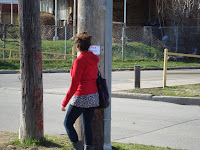

What I created was a "notice sign" that had a silly remark under it. The idea is that it will hopefully catch peoples eye and draw them into it. The intent is to get people to take that 1 extra minute in their day to notice something that they would otherwise disregard. I hung my sign up on one of the days this week when the weather was so amazing. I now that I was really excited about the weather but I saw some people who looked so wrapped up and on a mission. It would be nice if they could be able to spend some time and have fun outdoors. It was interesting to see the people walk by who noticed it and those people who continued on their merry way. There were also some people, like the girl above, who walked by but then took those few steps back to reread the sign. Although the project started off a little stressful, when I was finished it felt like a fun accomplishment.
Some links for Guerilla Art sites:
Definition of the week: Colour
- "is based in the passage of light. It is the visual sensation of light caused by stimulating the cones of the retina. As the light source changes, so does the the colour" (Schirrmacher & Fox, 2009, p. 136)
- colour can be categorized as
- primary- red, blue, yellow
- secondary- mixing 2 primary colours
- intermediate- mixing equal amounts of adjoining primary and secondary colours
- complemenatry- opposite colours of the colour wheel
- neutral- pigments that have no particular colour (black and white)
- colours also have physical properties such as hue, value, intensity, tint, and shade
Schirrmacher, R., & Fox, J.E. (2009). Art and creative development for young children, sixth edition. Belmont, CA: Delmar

No comments:
Post a Comment